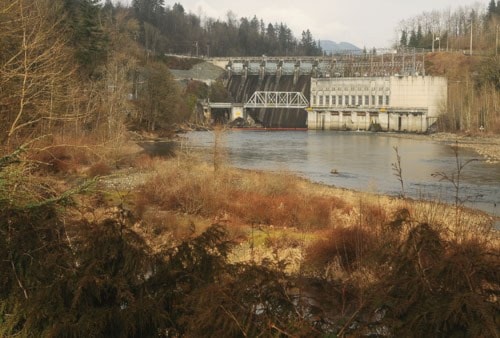Work to bring the Ruskin Dam and Powerhouse back to the future is about to begin, now that the B.C. Utilities Commission has OK’d the project.
The 82-year-old dam on Hayward Lake, just across Maple Ridge’s eastern border, will get a new wider, two-lane road (leading to Hayward Street) over its top, along with a sidewalk, new turbines to pump out more power, and seismic strengthening of its powerhouse.
As well, the concrete piers on the spillway will be replaced, the intake tunnels and penstocks will be upgraded and the right abutment will be improved.
Construction starts in weeks, creating 175 jobs over the six years of the project.
The utilities commission approved the project because it thought the $718-million project would be worth the greater power that would result, according to B.C. Hydro.
A major part of the project is replacing the three aging turbines, one of which was installed in 1930, while the second and third were added in 1938 and 1950. The new turbine-generators will largely come from Brazil, for about $80 million.
While they’ll be new, they won’t be that much more efficient than their predecessors. The new turbine-generators will be pump out only about eight-per-cent more power.
“This technology was invented 100 years ago and it’s pretty good technology,” Hydro VP of generation Chris O’Riley said Thursday.
“Hydro generation is really a simple process and the technology those days was pretty well refined.”
After the abutment is strengthened, crews will start on rebuilding the upper portion of dam and the spillway piers.
The lower part of the dam, built in 1930, is almost as good as new and doesn’t need any work.
“It’s a good concrete structure and it’s well fixed to the bedrock,” O’Riley said.
“I think the plant will be there another 80 years. One of the great things about hydro power is that it lasts a long time.”
Once renovated, the dam’s three 38-megawatt generators will produce 379 gigawatt hours of energy yearly, enough to light up 33,000 homes for a year.
While Ruskin produces less than one per cent of the B.C. Hydro’s power generation, it’s important because it’s located in the Lower Mainland, O’Riley added.
The seismic upgrades are supposed to have the dam survive a one-in-10,000 year earthquake.
The BCUC noted in its approval last week that “the age and condition of the existing [generating] units at the Ruskin facility represent a significant risk to reliability.”
Geoff Clayton, with the Alouette River Management Society, maintains that B.C. Hydro should include the construction of a $3 million fishway around the Alouette Lake dam as compensation for damming Stave Lake, north of Hayward Lake. Hydro though has rejected the fishway.
Alouette reservoir feeds water into Stave Lake from the Alouette generating station, which also used to produce power but has sat idle for the past 18 months. That used to put out enough power to light up 7,000 to 8,000 homes, Clayton added.
But O’Riley pointed out the Alouette generation station was built in 1928 and has just worn out. It could be rebuilt one day, but it’s not on the priority list, he added.
Clayton says allowing sockeye salmon access to Alouette Lake, so they could spawn would regenerate the entire river eco system.
Nevertheless, the short stretch of the Stave River, from the Fraser River to the base of the Ruskin dam is thriving.
Habitat restoration has rebuilt the chum salmon run to about 250,000, up from a couple thousand in the 1990s, he said.
He said the water use plan for the Stave that assures adequate flows for fish won’t be affected.
“With seismic improvements to the dam and powerhouse, and new generating equipment, this facility will continue to deliver clean, reliable power to the Lower Mainland for 75 years or more,” Energy Minister Rich Coleman said in a release.
The renovations also will reduce risk of spilling and ensure more consistent water flows for the fish downstream.
Dam facts:
• The BCUC is an independent regulatory agency of the provincial government that operates under and administers the Utilities Commission Act.
• The Ruskin Dam and Powerhouse is located in the District of Mission on the Stave River, north of Lougheed Highway at 287th Street, about 60 kilometres east of Vancouver.
• The Ruskin powerhouse was commissioned in November 1930, when its first generating unit went into service. The second and third units were commissioned in 1938 and 1950. No substantial upgrades have been made since the third generating unit was added to the powerhouse.
• With completion of the project, Ruskin’s three 38-megawatt generators will produce a total of 379 gigawatt hours of average energy per year.
• The Ruskin powerhouse will continue to generate electricity throughout construction. Once complete, the upgraded Ruskin facility will supply clean and reliable power to the equivalent of close to 35,000 homes.
• The estimated cost of the Ruskin Dam and Powerhouse Upgrade Project is about $718 million.
• The planned in-service date is March 2018.
• For more information on the Ruskin Dam and Powerhouse Upgrade Project and to watch a project video, please visit www.bchydro.com/ruskin.
